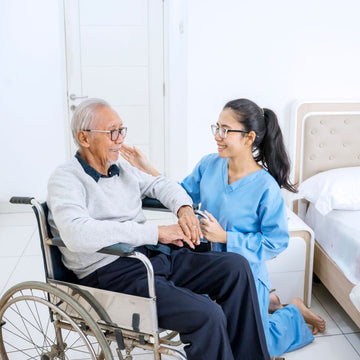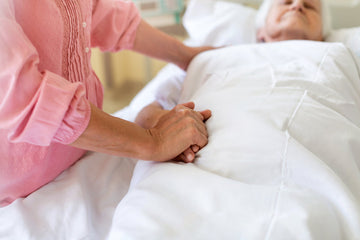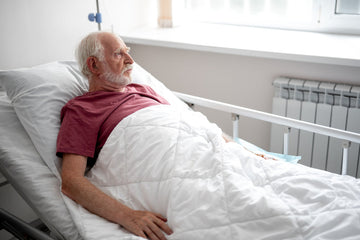
It is aptly said that The best way to TREAT a bedsore is to PREVENT it
Several questions arise in the mind of the caregiver
- How do we prevent bedsores? Do you always need a doctor to come and examine the patient every day?
- Do you need a special nurse?
- Is there a special diet to prevent bedsores?
- Can a CARING, ALERT caregiver takes GOOD care of a bedridden patient or wheelchair-bound patient to prevent the development of bedsores?
- How do we detect early whether a bedsore is developing and what are the warning signs to look out for?
- What are the warning signs or red flags the caregiver must know to call the doctor?
- Are we doing the right thing by caring for the patient at home?
- How do I spare my loved one the agony of bedsores?
You may have many more concerns. Do we have answers to these questions?
Well. It is NOT a difficult or impossible task to take care of your loved one at home! We need to follow a few simple principles to avoid the development of bedsores.
How do we relieve the pressure on the area?
Choosing the right bedsheets, mattresses, cushions.
With an understanding of what leads to the development of bedsores, researchers have developed special pillows, foam cushions, or mattress pads to reduce the pressure. Some pads are water- or air-filled to help support and cushion the area. For choosing the pillow, cushion, bedcovers, or bedsheets certain facts must be taken into consideration such as
- Is the patient wheelchair-bound or bedridden?
- Is the material cotton or synthetic? Will it increase sweating in the patient?
- Is the material smooth enough to prevent friction with the skin?
- Is the mattress or cushion the right fit for the bed or wheelchair?
Choose the bed mattress, bedsheet, and cushion with care.
Changing the position of the patient frequently
Change the position of the patient often. This simple principle can help relieve pressure on the skin and underlying tissues. If the person is in a wheelchair, try to change his position every 15 minutes. If the person is bedridden, then change his position every 2 hours.
How do we reduce friction with the skin?
- Apply barrier products like SOREZE to reduce friction with the skin. SOREZE is a Silicone-based skin protectant that can be applied for the prevention of bedsores. Soreze works by forming a thin, long-lasting, water repellent, breathable, protective barrier film on the skin that reduces friction and makes skin smooth and facilitates easy repositioning, and prevents bedsores.
- Powder the bedsheets lightly so the person’s skin does not rub to reduce friction with the skin

How do we detect early whether a bedsore is developing? What are the warning signs to look out for?
The early warning signs of a pressure sore may include
- Discomfort
- Changes in skin color
- Changes in local skin temperature.
The caregiver needs to be alert to these signs so that bedsores can be prevented.
How do we care to keep the skin healthy?
- Check the skin for pressure sores every day.
- Keep the skin clean and moisturized. Keep skin lubricated. Broken skin is especially prone to ulceration. The feet and legs are especially prone to dryness. Gently and consistently moisturize the skin to reduce friction and stress.
- Add a barrier cream like Soreze to your loved one’s incontinence care routine. Moist skin increases the risk of pressure ulcers because it breaks down more rapidly. If there is no sign of broken skin, apply a bedsore cream to protect against moisture and irritation.
How does one take care of bedsore?
Clean and dress wounds properly. Use mild soaps and warm water to clean broken skin to prevent infection. Dress wounds with wound care products specifically developed to create the moisture barrier necessary to protect oozing wounds. Excessive drainage may require frequent dressing changes.

How do we care for more advanced bedsores?
More advanced bedsores may require medical care. The wound may have to be cleaned with saline and covered with a special bandage. Keep the sore covered with a special dressing. This protects against infection and helps keep the sore moist so it can heal.
Talk with the doctor about what type of dressing to use. Depending on the size and stage of bedsore, a film, gauze, gel, foam, or other types of dressing may be used.
If a wound becomes infected, the person may have to be treated with antibiotics prescribed by a doctor.
Most stage III and IV sores will have to be treated by the doctor. Ask about any special instructions for home care.
Is there a special diet to prevent bedsores or for the patient with bedsores?
No! There is no special diet for patients with bedsores or to prevent bedsores. A balanced diet is important to improve immunity. In a patient with diabetes, it is important to follow the advice of the dietician about foods that can and can not be taken.
What other health tips are to be followed?
- Maintain the optimum weight. Avoid weight gain
- Ensure adequate sleep
- Light stretching exercises can help improve blood circulation
- Check blood sugar regularly.
- Make the person quit smoking as it may help the healing process
When should the caregiver call the Doctor?
Call immediately if there are signs of infection, such as:
- The person develops a blister or an open sore
- A foul odor from the sore
- Pus coming out of the sore
- Redness and tenderness around the sore
- Skin close to the sore is warm and/or swollen
- Fever
A CARING and ALERT caregiver can make a huge difference in the care of the bedridden or wheelchair-bound patient!!



